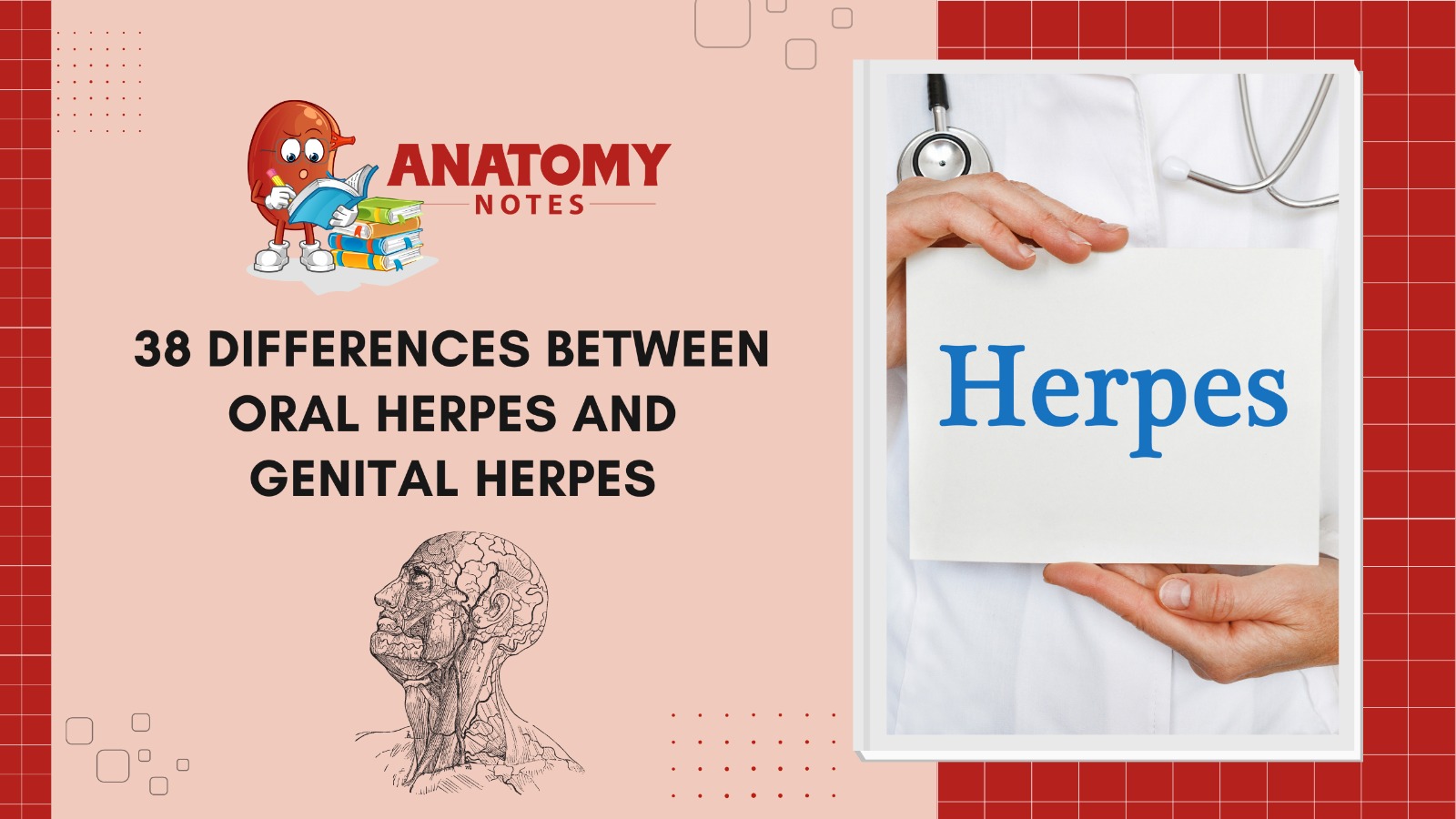Oral herpes and genital herpes are two diseases triggered through the herpes simplex virus (HSV).
The herpes simplex virus (HSV) causes the herpes virus infection. Herpes simplex viruses are classified into two types: HSV-1 and HSV-2. These viruses can produce a wide range of symptoms and affect various sections of the body, including the mouth, face, intimate area, and even other locations such as the eyes, most commonly affecting the skin and mucous membranes.
Oral herpesvirus (HSV-1)is a kind of herpes which mostly affects the mouth and face. It has the potential to induce cold sores or fever blisters on or around the lips. HSV-1 is frequently spread via physical touch, such as kissing or sharing utensils.
Herpes infections can result in painful sores, blisters, and ulcers on the affected areas. Outbreaks can often be accompanied by flu-like symptoms such as fever, body pains, and swollen lymph nodes. Herpes is very contagious and can be transmitted through direct skin-to-skin contact, even when no obvious symptoms exist.
It can also be passed down from mother to kid during childbirth.The virus remains dormant in the body’s nerve cells after the initial infection. It can reactivate and cause recurrent outbreaks of symptoms, especially when under stress, unwell, or with a weakened immune system.
Herpes simplex virus (HSV), typically HSV-2, though HSV-1 may also be to fault, causes a viral infection known as genital herpes. This condition primarily affects the anal and vaginal areas, which may cause sores, blisters, or ulcers to develop.
The herpes simplex virus causes genital herpes, a sexually transmitted illness (STI). It commonly spreads by sexual contact, whether it is vaginal, anal, or oral intercourse. In addition, oral-genital contact and skin-to-skin contact in the vaginal region are two other ways that genital herpes can spread. It’s important to keep in mind that someone who has oral herpes, which is commonly caused by HSV-1, could transmit the virus to their partner during oral intercourse.
Genital herpes is a viral infection caused by the herpes simplex virus (HSV), usually HSV-2, however HSV-1 may also be to blame. The anal and vaginal regions are the locations most commonly affected by this illness, and sores, blisters, or ulcers may form there.
Also Read: An Introduction to Tissues: Types, Origin, Membrane and More
|
No. |
Aspect |
Oral Herpes |
Genital Herpes |
|
1 |
Affected Area |
Mouth, lips, and surrounding areas |
Genital region, including the genitals, buttocks, and anal area |
|
2 |
Transmission Routes |
Oral contact, kissing, sharing utensils |
Sexual contact, including oral, vaginal, or anal |
|
3 |
Common Location |
Cold sores often appear on or around lips |
Blisters or sores on or around the genitals |
|
4 |
Symptoms |
Painful sores, itching, burning sensation |
Painful sores, itching, burning sensation |
|
5 |
Blister Formation |
Small fluid-filled blisters |
Small fluid-filled blisters |
|
6 |
Recurrence Frequency |
Recurrent outbreaks possible |
Recurrent outbreaks possible |
|
7 |
Triggers |
Stress, sun exposure, illness |
Stress, friction, illness |
|
8 |
Incubation Period |
2 to 12 days after exposure |
2 to 12 days after exposure |
|
9 |
Location of Sores |
On or around the mouth |
On or around the genitals |
|
10 |
Severity of Outbreaks |
Usually less severe than genital herpes |
Can vary in severity |
|
11 |
Transmission Prevention |
Avoiding direct oral contact during outbreaks |
Using condoms or dental dams during sexual activity |
|
12 |
Complications |
Cold sores generally not serious |
Can cause more severe complications |
|
13 |
Viral Shedding |
Can occur even without visible sores in Oral Herpes |
Can occur even without visible sores |
|
14 |
Cross-Infection |
Can cause genital herpes through oral-genital contact |
Can cause oral herpes through genital-oral contact |
|
15 |
Oral Symptoms |
Tingling, itching, burning sensation |
Tingling, itching, burning sensation |
|
16 |
Pain Level |
May cause discomfort during outbreaks |
Can cause significant pain and discomfort |
|
17 |
Herpes Whitlow |
Uncommon, but can occur if virus spreads to fingers |
Uncommon, but can affect hands if virus spreads |
|
18 |
Genital Symptoms |
Itching, pain, flu-like symptoms |
Itching, pain, flu-like symptoms |
|
19 |
Asymptomatic Shedding |
Possible even without visible sores |
Possible even without visible sores |
|
20 |
Herpes Meningitis |
Can cause viral meningitis in rare cases |
Can cause viral meningitis in rare cases |
|
21 |
Neonatal Herpes |
Can be transmitted to infants during childbirth |
Can be transmitted to infants during childbirth |
|
22 |
Viral Type |
Typically HSV-1 |
Typically HSV-2 |
|
23 |
Diagnosis Methods |
Clinical examination, viral cultures |
Clinical examination, viral cultures |
|
24 |
Treatment |
Antiviral medications |
Antiviral medications |
|
25 |
Preventive Measures |
Avoiding oral contact during outbreaks |
Using barrier methods during sexual activity |
|
26 |
Physical Discomfort |
May experience pain and discomfort |
May experience pain and discomfort |
|
27 |
Antiviral Suppression |
Can help reduce frequency of outbreaks |
Can help reduce frequency of outbreaks |
|
28 |
Herpetic Whitlow |
Uncommon |
Can affect genital area if virus spreads |
|
29 |
Transmission during Outbreaks |
Highly transmissible during outbreaks |
Highly transmissible during outbreaks |
|
30 |
Management Strategies |
Avoid triggers, antiviral medications |
Avoid triggers, antiviral medications |
|
31 |
Stigma |
Can be stigmatized, but common |
Can be stigmatized, may carry more stigma |
|
32 |
Vaccine Availability |
Vaccines not commonly available |
No vaccine available |
|
33 |
Complications during Pregnancy |
Generally not a significant concern |
Requires careful management during pregnancy |
|
34 |
Recurrent Outbreaks |
Can recur frequently |
Can recur frequently |
|
35 |
Transmission to Newborn |
Risk if active sores during childbirth |
Risk if active sores during childbirth |
|
36 |
Sexual Activity Impact |
Can engage in sexual activity with precautions |
Can engage in sexual activity with precautions |
|
37 |
Risk of Dissemination |
Limited risk of spreading to other body parts |
Risk of spreading to other genital areas |
|
38 |
Virus Latency |
Can remain dormant in nerves |
Can remain dormant in nerves |
Also Read: An Overview of the Lymphatic Systems Function & Organs
Frequently Asked Questions (FAQ)
Q.1 The herpes virus: how is it spread?
Herpes is mostly passed from person to person through close, direct skin-to-skin contact, often during sexual activity or close personal connections.
Q.2 What symptoms and indicators are present in herpes?
Along with tingling, discomfort, and small red bumps or blisters, the affected area may also become inflamed. Sometimes, flu-like symptoms can be present during the initial outbreak.
Q.3 Is there a cure for herpes?
Although there is no known cure for herpes, antiviral medications can help manage outbreaks, alleviate symptoms, and reduce the risk of transmission.
Q.4 How is genital herpes different from other STIs?
When genital herpes is present, typical blisters or sores appear. While some STIs may not even have symptoms, this one can occasionally break out again
Q.5 What typical genital herpes symptoms exist?
Some of the symptoms include burning, tingling, pain, and the development of sores or ulcers in the vaginal and anal regions. Initial epidemic symptoms could resemble those of the flu.
Q.6 Can Sharing private items cause herpes to spread?
Herpes is rarely spread through the sharing of items like towels or flatware and is frequently spread through direct skin-to-skin contact.





